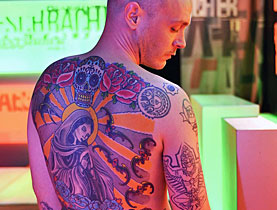
Human canvas to go on show

A Zurich man who sold a tattooed part of his body as art is preparing to exhibit himself for the first time at a fair in China.
The tattoo on Tim Steiner’s back was bought last week by a German art collector for €150,000 (SFr240,000) in a deal coordinated by the Zurich gallery De Pury & Luxembourg.
The gallery, Belgian artist Wim Delvoye and 32-year-old Steiner all took a cut of the money.
In return Steiner is required to exhibit the work three times a year in public and private shows, the first of which will be the Asia Pacific Contemporary Art Fair in Shanghai next week.
The sale agreement extends further, stating that after Steiner’s death the tattoo and its skin canvas will revert to the new owner, contemporary art collector Rik Reinking.
De Pury & Luxembourg told swissinfo that it was the culmination of all past works by the artist whose pieces have included the Cloaca machine, which simulates the human digestive system, and a tattoo series on pig skins.
“The tattooing started with the pigs but it was always Delvoye’s goal to realise the same on a human back and hence stretch the boundaries of the acceptable to the maximum,” said the gallery’s sales director Stephanie Schleiffer.
“In Tim Steiner he found the back and has turned the young man into a work of art.”
Unusual contract
Delvoye started creating tattoos on pig skins from slaughterhouses and then began working on live pigs bred in a farm studio complex in China, using images such as the Louis Vuitton design and Walt Disney characters.
Steiner’s tattoo of the Madonna surrounded by Asian and African ritual symbols began as part of an art performance piece in 2006 and was completed in 2008.
De Pury & Luxembourg said the sale was an “integral part of the work itself” and describes the contract as a dissertation on the definition of an artwork, the art market and the ethical and legal questions it raises.
It includes a provision giving the collector the right to sell the work on again. The buyer is also insured against opposition by Steiner’s family who have signed a binding document agreeing not to intervene in any attempt to remove the tattoo after his death.
Moral questions
The work, called Tim, sold for the same price as Delvoye’s pig skin tattoos, which Bernard Fibicher, director of the Musée Cantonal des Beaux-Arts in Lausanne, says is a comment by the artist on the state of the art market.
The museum exhibited some of Delvoye’s pig skins this spring, and Fibicher added that the value of the work lay not in the design itself but rather in the concept.
“The role of art is to interrogate, not to reassure. This act disturbs society: a person becoming a work of art poses moral and legal questions. They want to keep his skin when he dies; that becomes macabre and disagreeable, but interesting,” he told Le Matin newspaper.
“Sociologically it is interesting. Donating organs to save a life is legal and noble. Mixed with art the gesture lose its usefulness but sets an example.”
He said Delvoye had managed to put his finger on a glitch in the system.
swissinfo, Jessica Dacey
The idea of using human beings as canvases is not new. In 1961 Piero Manzoni created works of art on men and women’s bodies.
Swiss writer Jürg Federspiel wrote about tattooing a work of art on to a woman’s bottom, in his book Geographie der Lust in 1989.
In 1988 Santiago Sierra did a performance piece in which he tattooed a line across the backs of a group of Cuban unemployed men. The participants were paid.
French journalist Harry Bellet tried to leave a tattoo by Wim Delvoye to the Pompidou Centre in Paris in his will, but the museum refused for “legal reasons”. British filmmaker Ben Lewis also wanted to sell his Delvoye tattoo via the Christie’s and Sotheby’s auction houses but they declined to take part.
Delvoye first started tattooing pigskins back in 1992. The skins were first obtained from slaughterhouses and later he began using live pigs based on the idea of the pig as a bank – a “piggy bank” – with designs that expanded as the pigs grew. The pigs were kept on a farm in China, sedated, shaved and Vaseline applied to the skin before the tattoos were done.
His work on Tim Steiner, a musician from Zurich, started in 2006 as a performance in the De Pury & Luxembourg gallery and was completed in 2008. It will be exhibited in its entirety for the first time at the Art Asia Pacific show in Shanghai from September 9-13.

In compliance with the JTI standards
More: SWI swissinfo.ch certified by the Journalism Trust Initiative





























You can find an overview of ongoing debates with our journalists here . Please join us!
If you want to start a conversation about a topic raised in this article or want to report factual errors, email us at english@swissinfo.ch.